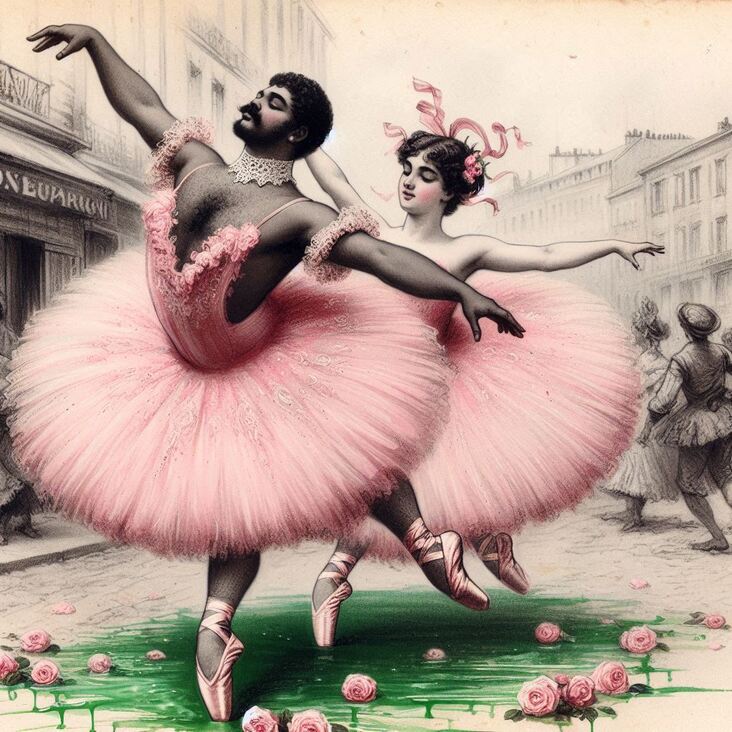
Bonjour mes chéries,
Welcome back to Pink-Tutu.com, your one-stop shop for all things tutus, ballet and, of course, the most fabulous shade of pink imaginable. It’s your girl Emma here, fresh from a rather exhilarating journey through the mists of time and straight back into your screens.
This week, our journey takes us back to January 8th, 1850, a rather crisp, bright day in Paris, the city where tutus truly found their place on the world’s stage. Today’s Tutu Tuesday adventure is going to delve into a historical question I often find myself pondering: what exactly were ballerinas wearing before the tutus we know and adore came along? I’m excited to tell you about how our love for those fluttery, billowing masterpieces came about.
The year is 1850, a grand era for ballet, filled with romantic ideals, beautiful melodies, and captivating performances. We're in the midst of what's called Romantic Ballet, a style known for its dreamy storylines and intricate choreography. As the saying goes, a truly stunning dancer has to have an even more spectacular costume to complement their every graceful step. You can't just wear a frock that weighs a ton, right? So let's imagine for a moment, that you are Marie Taglioni, the reigning Queen of ballet back then. A dancer like you is so light on her feet, but her performance, especially with her costume, should have the strength to fly. The most fashionable ladies in the whole of Paris would turn their noses up if they saw your costume weighed you down! It’s this love of artistry and the need for something truly magnificent that would ultimately inspire the creation of the tutu.
You might be surprised, darling, to discover that what ballerinas wore pre-tutu was quite bulky and, dare I say, even rather comical. Long, cumbersome, flouncy skirts weighed them down, which naturally didn’t look very good in motion, let alone showcase the skill of those fabulous leg movements. Ahem, who wants to see a big, clunky, frilly skirt moving around instead of the ballerinas themselves?
Now imagine the sheer magic of the tutus in this age! Romantic Ballet became, and remains to this day, known for showcasing graceful movements. It’s the era of pointe work. (Ahem, ever heard of ‘Sleeping Beauty’, dear? You know, the grand ball scene where those delicate slippers and amazing jumps first really take centre stage?!)
So what are these “tututs” really all about? What's their fascinating story?
Firstly, it was Marius Petipa, who in the 1880s, began calling this fashion staple “a tutu”. (I do love the alliteration. Isn't that charming?!) But this specific costume did not come from nowhere.
Marie Taglioni is seen by many, and indeed, considered the one who was most influential in helping our beloved tutu find its place on stage. It all came about when the big old bulky skirt-that-never-ended started to go out of style and it was decided, rather wisely I say, to move towards a more simplified design. Think shorter skirts and more fabric. The ‘skirt’ of these earlier designs would usually be made of an ethereal, flowing fabric like gauze, silk, and even linen. A long ‘leg-o-mutton’ sleeve with frilled fabric, called “bouffant” would help provide an impressive appearance in the style of the time. Think of these “leg-o-mutton” sleeves as the ‘ruffle’ in our modern day tutu! These shorter skirts were ideal to enhance the ballerinas’ incredible jumps and to reveal those elegant steps - after all, how could we have a dance of pure elegance without the ballerinas’ grace to enchant the eyes of those looking on!
You can imagine how the audience’s collective hearts must have stopped for a minute when this more airy, lighter version of a costume was first unveiled to the public. All eyes were fixed on these dazzling dance performances, where for the very first time, those delicate, agile leaps really captured hearts and imaginations, giving the audience a unique glimpse of this exquisite performance art.
Of course, what’s a ballet without music?! It’s in this historical time-frame, back in 1850, that my trip takes me. You'll see in today's edition of "Les Ballet's, The Paris Shows!" (Yes, the latest Parisian guide!), a ballet called 'Giselle', performed by the ballet dancers at the Opera House. It’s a show, and believe me, an absolutely MUST SEE - but remember to wear your pink tutu because this dance will steal your heart. If there’s one ballet everyone needs to add to their dance card, this is it! The story's absolutely tragic, romantic, beautiful, and filled with emotion. Oh! You need to see it, truly, if you are an avid lover of ballet. The costume, especially Giselle’s, is incredibly elaborate! There are so many delicate and feminine details! And a full length costume. Not something you will find at a dance studio class these days! I can’t wait to see how I can recreate it in a shorter version of this classic style on a whim! A ‘modern’ take, you see!
Speaking of ballet class, darling, have you already been in the studio this week to perfect your turn-out? Let me know what you've been up to. Tell me in the comments below which one of these amazing, historical ballet moments is your favorite - which will it be? ‘La Sylphide’ or ‘Giselle’?. And of course, if you’re as smitten by these classic performances as I am, share your favourite photos and post them with your fellow dance lovers - don't forget the hashtag, #TutuTuesday.
See you next week!
Xx Emma

